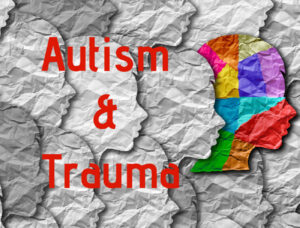Back to Basics: Beginning Trauma Treatment with an Individual with ASD

Autism spectrum disorder (ASD) continues to confuse and befuddle people. How do I interact with this person? What is this person capable of? What should I expect? What should I do or not do? There are simple questions and complex questions. There are also simple answers and complex answers. Then, there’s another factor to throw in the mix – trauma. Supporting and treating a person with special needs who has suffered trauma can be a daunting task. Whether you are a caregiver, parent, friend, teacher, or mental health professional, your role matters greatly. The support you give makes a difference in the healing and resolution of traumatic experiences. The number one rule I can recommend is patience. Along with that, gentleness, kindness, and more patience. For a survivor, navigating through life in the wake of a trauma is painful and challenging enough, but it can be even more frustrating if the people helping are differently abled from you and you do not know how to help.
Let’s start with some basics. As a clinician, it is important that you familiarize yourself with the diagnostic criteria and understand that the spectrum includes people with a very wide range of abilities and disabilities. It is important to note that some people with ASD have a comorbid intellectual disability (ID), some have genius level IQs, and the rest are found everywhere else on the IQ scale, because ASD can be found throughout the whole range of intellectual ability.
The first two diagnostic criteria are about deficits in social communication and social interaction as well as restricted, repetitive patterns of behavior, interests, or activities, according to the DSM 5. To oversimplify it, this means that your client may have a difficult time connecting with you and stepping outside of their comfort zone. It will be crucial for you to remember three things in your work. Safety, neutrality, and attunement.
Safety. A person with ASD may feel unsafe in the world for a variety of reasons—sensory stimulation may be perceived as painful (or pleasurable), they may experience generalized or specific anxiety, they may have been exposed to any number of traumatic experiences, and neurotypical humans can behave unpredictably. While you, the clinician, may be confused by your client’s behavior, remember that it is a two-way street. Your behavior may be confusing and unsettling to them as well. You can increase the feeling of safety by using non-threatening body language, setting clear expectations, creating a predictable schedule, and giving the client choices. If your client is smaller than you, do not tower over them. Instead, kneel or squat down to their level. Sit on the floor or in a chair with them. Give the client many choices—even if the choice seems benign to you. “What color marker would you like?” “Yellow or green paper?” “Do you want to sit in here or in there?” “Would you like to read this yourself, or should I read it out loud?” Giving a person choices empowers them to have some control, to assert their desires, and to be successful in tiny moments each day, leading towards personal growth and greater successes in the future.
Neutrality. As previously noted, sensory stimulation can affect a person with ASD differently. It can be exciting or overwhelming, and it may even alternate between those extremes without warning. As a helper, you can try to provide a space with little visual distraction—shades over the windows, blank or muted walls, consistent gentle lighting, and limited sound all tend to be beneficial adaptations. Your client may appreciate if you do not wear perfume or cologne. You should always ask before you touch a person with ASD (really any person, anywhere, because you do not know their touch preference, their trauma history, or whether you have permission to touch them).
Additionally, some individuals with ASD struggle to make eye contact. Do not force this. Many people will reach for a child and turn their head when seeking eye contact. This is invasive and can make the child uncomfortable. They may be avoiding eye contact in order to properly listen and pay attention to what you are saying. They may be avoiding it because your eyes are too distracting and visually overstimulating. Whatever the reason, try to remember that there are other ways to connect and other ways to tell if a child is listening to you.
You also should not take any reactions personally. You may need to modify your behavior or your demands, but remember that your goals are to help, to empower, and to ensure your client dignity and respect. Remain neutral, as best you can, for the sake of your client.
Attunement. How do you keep all of these instructions in mind at once? Through attunement. Attunement is a therapeutic practice which basically means that you are connected to the individual. It is a way of building a relationship with solid rapport and empathizing with them. It requires mindfulness and intention, because if you are distracted, you cannot be attuned to your client in that moment. Many adults learn about attunement through parenting. Being aware of and responsive to your baby are the first two skills necessary to be successfully attuned. This is the same for your client. You must be aware of them and responsive to them in order to build a supportive relationship.
You can think of it as “tuning in” to all the nonverbal information the client is giving. Pay attention to their body language, facial expressions, movement qualities, rate of speech, tone of voice, and voice volume. When you are attuned, you can see and feel subtle changes in these nonverbal cues, as well as in their behavior, emotional state, and narrative. This is basically a superpower that you can acquire through practice.
Remember: safety, neutrality, and attunement. Also, patience, gentleness, kindness, and more patience. These are the key ingredients for your work. They are only very basic suggestions for how to approach and begin a therapeutic relationship with an individual with ASD. There are a multitude of important topics that I have not covered here. However, I hope that this will serve as a foundation and launchpad for your clinical work with people with ASD who have suffered trauma.
By Gretchen Tucker
